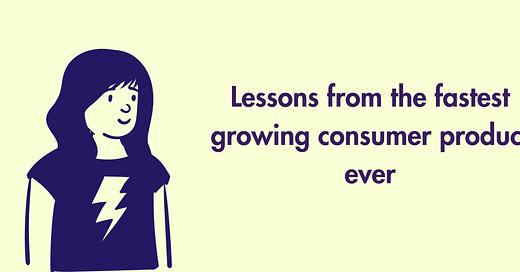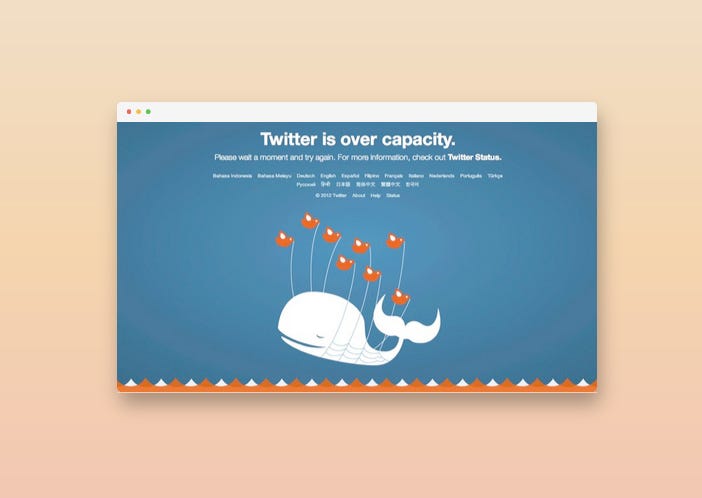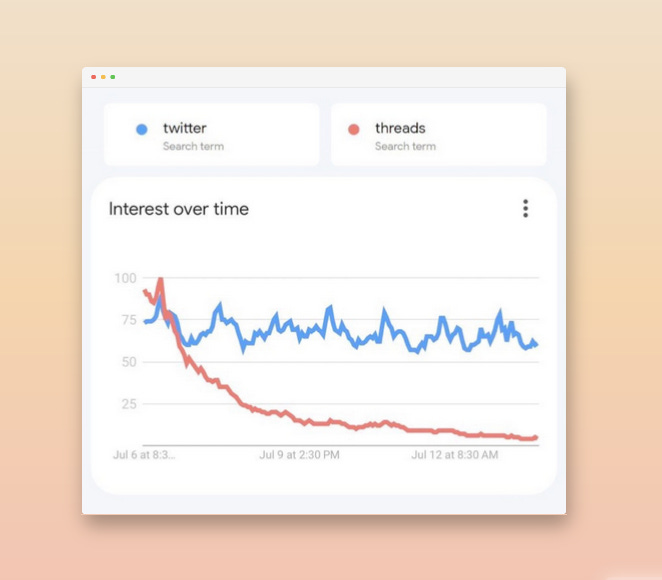Lessons from the fastest growing consumer product ever
As Threads became the fastest app ever to 100m users, what takeaways for other startup founders and product managers?
What can we learn from the launch of Threads, the new Twitter clone from Meta?
Yes, it is a clone - even Mark Zuckerberg doesn’t deny it, judging by his one and only Tweet for the first time in 13 years.
Launching on July 6th 2023, Threads became the fastest app ever to reach 100m users, achieving this milestone in a matter of days.
Even scaling to this many users without issue is a feat of engineering*.
You might remember that for years Twitter would frequently display the ‘fail whale’.
Scaling is hard, but Meta was clearly well prepared.
More than well prepared.
This is arguably the most successful consumer product launch ever.
So what can we learn?
Let’s dive in 🚀
1. Timing is critical.
Entering a market at the right time is critical.
Too early, and the market won’t be ready.
Too late, and someone else may have capitalised on the opportunity.
A classic example of the market being too early is Webvan. Back in the early 2000’s, Webvan became a poster child of the dot-com excess, when it’s incinerated billions in investors money trying to build a grocery delivery business.
Fast forward to today, and Instacart has succeeded with nearly the same business model. Instacart learnt from Webvan, relying on supermarket infrastructure rather than trying to build their own, but what made the biggest difference was that consumers are much more used to buying online in a way they weren’t in 2000.
When Instacart launched, the market was ready.
Threads has launched at a time when Twitter is stumbling. Despite Musk tweeting that Twitter is growing, there’s some evidence that people are using it less.
Half of advertisers have abandoned it. A number of high profile celebrities left. Product iterations have been messy and slightly schizophrenic.
This has all contributed to a sense that Twitter might be vulnerable.
And this sense of chaos seems to have opened a gap which Threads has jumped into.
Perhaps a year earlier or a year later, the Threads launch may not have had the same impact.
But in 2023, the timing was right.
2. Never underestimate distribution
Making Threads a standalone app is a critical product decision. When Instagram looked to take on a rising Snapchat, they built Instagram Stories into the existing Instagram app.
The launch of Stories was a huge blow to Snap, with the company shrinking to a shadow its former self.
This time round, looking to take on Twitter, they decided to go with a standalone app.
This meant Facebook had to solve the ‘cold start problem’, i.e. when they launch, they wouldn’t have any users.
So what did they do? They made sure that you could bring over your Instagram social graph when you signup.
When you join the app and log in, you are presented with a screen to follow all of your Instagram friends. For any friends that you follow that don’t have Threads, this then sends them a notification to download it.
This might be considered a rather hostile design decision, but it is clearly very effective.
Importing the entire Instagram social graph from the beginning was only the first step.
But the integration didn’t stop there. They put multiple touchpoints for users to cross pollinate. Here’s two;
a) Instagram users are prompted to join Threads.
From within the Instagram app, you have a prominent Threads logo next to the existing channel username.
b) Give people a boost when the join Threads. “Pending follows” allows people to follow existing Instagram users even before they join Threads. This means if and when they download the app, they already have some followers.
This gives new users a better feeling than starting from 0.
This tight integration with Instagram, which currently has over 1.2 Billion monthly active users, gave Threads a massive distribution advantage.
Never underestimate distribution.
Frankly, Facebook could have launched almost any app and it would have gained significant traction with this distribution advantage.
Few PMs have the advantage of being able to plug into an existing user base this large. Even so, there will be ways you can integrate new products with your existing userbase.
3. Don’t wait for perfect.
Threads shipped with a number of issues, including the fact that it was, ironically, quite hard to create a thread. (This appears to be fixed now.)
It also is missing a number of features - you can’t switch between multiple accounts, there is no desktop version and the feed is often dominated more by celebrity posts than the people you actually follow.
Even so, the team chose to ship.
The work on Threads only started in January, so a 6 month time to launch is impressive for a company as big as Facebook.
I’ve certainly been in companies where it took 6 months just to agree a product spec.
Compare this success to the approach Facebook took with the Metaverse. With this project, they invested tens of billions of dollars and were unable to capture any significant user numbers.
Combing back to Threads, they could have delayed the launch further. They could have decided they needed a few more features before it was really ready to take on Twitter.
There’s always more that can be done. There’s always more features that could be built.
But they didn’t. Instead they now have real users that they can now build new features with, and the data they gain will be able to inform the next product iterations.
This shows just again how valuable having your product in front of real users is.
4. A perfect launch may not be enough
A lot of companies have started to try to take on Twitter recently; Mastodon, Truth Social, Bluesky, to name a few. None have yet really managed to break out from the pack, that is until Threads came along.
The question is, will Threads continue to grow, pushing Twitter slowly into irrelevance?
I wouldn’t be so sure just yet.
If Threads has about 100m users, that means it has approximately 4% of Instagram’s user base.
Is 4% good? It’s hard to know.
My gut says that they should be able to bring over a higher % of active Instagram users.
Even if they do, Threads might yet prove to be a flash in the pan - there are signs that interest may be fading.
And engagement is already dropping. DAUs are down 40% and average daily time per user dropped 4x.
Some dropoff is of course to be expected after the initial excitement.
The Threads launch was a near perfect case study in how to launch a product. They scaled to hundreds of millions of users without a hitch.
Many people want to check out the new platform. But the challenge for the Threads team is whether they are able to build on this white-hot launch and build something sustainable.
Twitter is also fighting back, one approach they have used is to start sharing thousands of dollars of ad revenue with creators. Oh, and by suing Meta.
The launch of Threads is just the start of the journey - now the marathon begins.
Facebook’s latest social product may mark the beginning of the end of Twitter, as the launch of Instagram Stories heralded the decline of Snap. Mark Zuckerberg clearly knows social - I wouldn’t bet against him.
But only time will tell.
What do you think? Have you switched to Threads? Or are you sticking with Twitter?
Let me know in the comments below.
Until next time,
Jamie
*One issue that was more amusing than problematic was that Mark Zuckerberg’s own Threads posts were unavailable for a short time.
Did you enjoy this edition of Exponentially?
Please take a second to help me improve!









